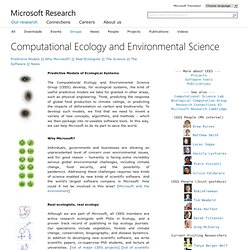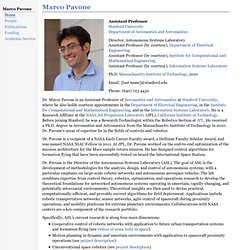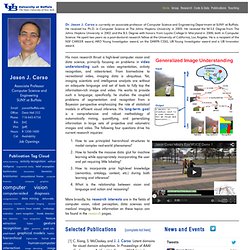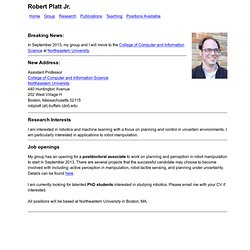

Contact - Eric Diller. Mechanical and Industrial Engineering. Research areas.

Shuzhi Sam Ge's Homepage. Animesh Garg. Personal web Alberto Rodriguez. Francesco Bullo's Home Page. Machine Learning and Perception. Computational Ecology and Environmental Science. Computational Ecology and Environmental Science Predictive Models || Why Microsoft?

|| Real Ecologists || The Science || The Software || News Predictive Models of Ecological Systems The Computational Ecology and Environmental Science Group (CEES) develop, for ecological systems, the kind of useful predictive models we take for granted in other areas, such as physical engineering. Think, predicting the response of global food production to climate cahnge, or predicting the impacts of deforestation on carbon and biodiversity.
Why Microsoft? Individuals, governments and businesses are showing an unprecedented level of concern over environmental issues, and for good reason – humanity is facing some incredibly serious global environmental challenges, including climate change, food security, and the possibility of pandemics. Real ecologists, real ecology The science: predictive modelling of the biosphere The software: new tools for new science Latest News [for all news click here] Projects. Mac Schwager. Marco Pavone. Dr.

Marco Pavone is an Assistant Professor of Aeronautics and Astronautics at Stanford University, where he also holds courtesy appointments in the Department of Electrical Engineering, in the Institute for Computational and Mathematical Engineering, and in the Information Systems Laboratory. He is a Research Affiliate at the NASA Jet Propulsion Laboratory (JPL), California Institute of Technology. Before joining Stanford, he was a Research Technologist within the Robotics Section at JPL. He received a Ph.D. degree in Aeronautics and Astronautics from the Massachusetts Institute of Technology in 2010. Dr. Dr. Dr. Specifically, ASL's current research is along four main dimensions: The publications of the ASL lab are available here.
News September, 27, 2013: We submitted a paper about a unifying framework for time-consistent, risk-averse model predictive control to ACC 2014. Jason J. Corso. Video2Text.net: A website and web-service for automatic conversion of videos to natural language sentences based on the video content.

This website showcases our work in the vision+language domain. YouCook data set: 88 challenging videos of various cooking (third-person viewpoint, different backgrounds, dynamic camera and person movement) with natural language annotations (about 8 per video) and object and action annotations. Includes a benchmark ROUGE scoring evaluation. The data set was published with our CVPR 2013 paper.
Hierarchy Agreement Index: implementation of our AAAI LBP 2013 cross-hierarchy evaluation tool for general use. Random Forest Distance -- tree-structured metric learning that implicitly adapts the metric over the sample space based on our KDD 2012 paper. Action Bank full code and processed data sets [direct link to code] Robert Platt Jr. Breaking News: In September 2013, my group and I will move to the College of Computer and Information Science at Northeastern University.

New Address: Assistant Professor College of Computer and Information Science Northeastern University 440 Huntington Avenue 202 West Village H Boston, Massachusetts 02115 robplatt (at) buffalo (dot) edu Research Interests. GradDecision - Helping you get into your dream school. Shriram Krishnamurthi: Advice to Graduate School Recommendation Letter Writers. First version: 2008-03-25. Revised: 2008-03-26 (thanks, Kathi Fisler). Revised: 2010-10-21, 2010-11-20, 2012-05-04. Some years ago I was talking to a visiting scholar who was a faculty member in a foreign country. I asked her why letters from her country seemed to be so uninformative. She pointed out that there, faculty never letters: they only write them. The facts were hardly surprising—after all, this is the system I grew up with in India—but after hearing the way she put it, the proverbial bulb lit up. Disclaimer: This is an extremely personal opinion. What this document is about: Writing effective recommendation letters for PhD students applying to computer science PhD programs in the US.
ETH - IDSC - With Prof. D'Andrea. Interested Students Current ETH students interested in a Bachelor Thesis, Master Thesis or Semester Project, click here.

Non-ETH students interested in a project or internship, click here. Students interested in applying to the Master's Program, click here. (You may review our topics and make inquiries to the project supervisor directly, but note: you must be admitted to the DMAVT Masters program before you can apply to do a thesis.) Prospective PhD and Post-Doctoral Researchers, click here. AcademicKeys.com: Higher Education Jobs and University Jobs. Research at the Faculty of Engineering — Technische Fakultät. Ruina personal home page. Paul Newman - Homepage : Main - Home Page browse. Subramanian Ramamoorthy Home page. Rajesh Rao's Home Page. General Outline of the Recommendation Letter. General Outline of the Recommendation Letter Recommendation letters are letters written by professors who know you, assessing you capacity to meet the requirements of a program you are applying for.

They're supposed to help decision-makers to get a better picture of your potential. Due to different reasons, if you are a student in Eastern Europe (including Russia) you will often find yourself in the position to write these letters yourself. The professor will, in this case, only proof-read and sign the text. First Paragraph Next 2-4 Paragraphs Final Paragraph Some Remarks Sample Outline of the Recommendation Letter First Paragraph Recommendation letter usually starts by stating the name of the professor who writes the letter and his/her title, together with the name of the student for whom the letter is written.